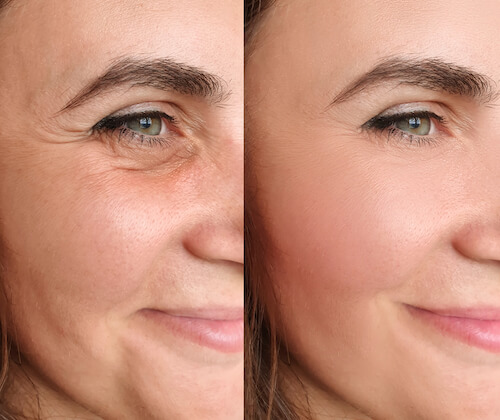Bell’s Palsy

Bell’s Palsy is an inflammatory condition that affects the nerves that control the muscles of facial expressions. This condition can be caused by a sudden viral infection and result in a facial droop that typically manifests itself on one side of the face. Patients often experience abnormal twitching and a loss of facial nerve function. Bell’s Palsy is certainly treatable, but results will vary depending on the patient’s case and sometimes the level of seriousness of the triggering event – whether it was infection, stroke, trauma, or facial tumors.
Surgery is a solution for Bell’s Palsy with the goal in mind to re-establish normal muscular movement in the face. Often, surgery will not be a consideration until facial nerve function is not within normal parameters for at least 12-18 months. Surgeons who specialize in facial paralysis can repair a patient’s nerve damage surgically, or treat them non-surgically through steroids and antiviral medication.
In cases where surgery is required, some postoperative complications might include: infection, bleeding, and the need for surgical drainage of the treated area. Eighty percent of individuals recover from the surgical treatment of Bell’s Palsy in a short period of time; however, some patients have more extended complications with the nerves that control smiling and eye closure. In rare cases, even after surgery – a patient might not be able to achieve results that yield full nerve regeneration.
Entropion/Ectropion Repair
Entropion
An Entropion repair is necessary when the turning-in of an eyelid causes enough discomfort to warrant surgical treatment. This eye condition is rare and can result from the aging of eyelid muscles. Some of the symptoms may include:
- Excessive tearing
- Irritation or pain from eyelashes rubbing against the eye
- Light sensitivity
- Redness of the eye
- A decrease in vision
- Gritty eyes or a mucus discharge
This condition can be eased through eye lubricating ointments, artificial tears, BOTOX, or sutures; however, these options will only temporarily treat the symptoms.
A surgical Entropion repair is an outpatient procedure requiring local anesthesia. Post-surgery, patients typically wear a patch or a bandage to protect the eye(s) and minimize bleeding for 24 hours. If the condition goes untreated, it can permanently damage the cornea and lead to vision loss.
Ectropion
An Ectropion condition exposes the inner eyelid surface due to an outward-turned eyelid. The lower lid pulls away from the eye preventing tears from draining properly into the puncta. Some of the symptoms may include:
- Irritation
- Watery eyes
- Light sensitivity
- Noticeable redness in the eyes
- Excessive dry eye
This condition can be caused by any number of factors which are often related to age such as: eyelid growths over time, scarring from previous surgeries, weakening of the muscles under the eyes, and previous eye trauma.
Irritation from an Ectropion condition can be treated with artificial tears and eye lubricating ointment. When surgery is required, an incision is made at the outside corner of the eyelid and the eyelid is reattached and secured to surrounding tissues and the upper eyelid. If a patient requires surgery, the procedure is outpatient utilizing local anesthetic. Often patients will experience immediate positive results post-surgery with minimal discomfort. Infection, which is a risk with any surgical procedure, is uncommon in an Ectropion surgical repair.
Eyelid Reconstruction

An Eyelid Reconstruction procedure is typically used to repair trauma, damage resulting from tumors, conjunctive anomalies, etc. Because eyelids are an essential function of the face, a surgical reconstruction procedure might be necessary to correct deficits resulting from eyelid defects.
For more information on Eyelid Reconstruction click here: Blepharoplasty
Thyroid Eye Disease
Thyroid Eye Disease (TEM) often referred to as Graves’ Disease, is an autoimmune disorder that occurs when the body’s immune system attacks the tissue around the eyes. The condition affects eyelids, eye muscles, and tear glands as a result of inflammation of the fatty tissue behind the eye. When an individual has TEM, the appearance of the eyes often results in “bulging” or “staring” eyes. Usually, this same autoimmune disorder impacts the thyroid gland and most commonly results in hyperthyroidism (overactive thyroid). In rare cases, Graves’ Disease can cause the thyroid to be underactive (hypothyroidism).
Some of the symptoms of TEM include:
- Bright light sensitivity
- Swelling of the upper or lower eyelids
- Blurred or double vision
- Bags under the eyes
- Redness of the eyes
- Pain and discomfort behind the eyes
The treatment of Thyroid Eye Disease requires careful monitoring with the primary objective being the preservation of vision. Patients might be prescribed medication from their physician, but in critical cases, surgical treatment may be required to correct double vision and reduce eyelid retraction. The benefit of surgery is that it can return the eye(s) to a normal position in the socket – also known as orbital decompression.
Dr. Christine Bokman at Frantz Cosmetic Center is very knowledgeable in the treatment of Thyroid Eye Disease and will prescribe the right solution for patients in need of comprehensive management of this disease.
Orbital Tumors, Decompression and Fractures
Orbital Tumor
An orbital tumor develops when abnormal tissue forms in the area(s) surrounding the eye socket. Patients with orbital tumors might experience numbness, itching, tingling or pain around the eye. More noticeable symptoms such as bulging eyes, droopy and swollen eyelids, and even vision loss may also be warning signs of a possible orbital tumor.
It is critical that patients who experience these symptoms have a thorough examination with an oculoplastic surgeon – since it is likely that these lesions impact vision and the area surrounding the eye(s). Our surgeon at Frantz Cosmetic Center will be able to recommend a comprehensive treatment plan accordingly.
Orbital Decompression
Orbital decompression is a procedure for “bulgy eyes” (medically referred to as: exophthalmos or proptosis) and is often used to treat Graves’ Disease – also known as Thyroid Eye Disease. Surgery becomes necessary when orbital swelling causes double vision, an inability to completely close the eyes, and even vision loss. A portion of the walls of the eye bones (the orbit) along with excess fatty tissues behind the eye are removed, creating more room and allowing the eye to move into a better position in the eye socket. Eyelid repositioning and/or the removal of scar tissue around the eye muscles might also be necessary in order to achieve the ideal outcome.
Post-operatively, patients often experience improvement in dry eye, double vision, and eye closure, and are able to achieve an overall aesthetically pleasing appearance. The surgical recovery period is usually 7 to 10 days, and our surgeon will prescribe you with a post-op pain management regimen that is right for your needs.
Orbital Fracture
An orbital fracture occurs when trauma to the face – particularly surrounding the eye area – results in breakage of the bone(s) surrounding the eye. These incidents often take place in sports-related settings, and injured athletes may exhibit bruising around the eyes, inhibited vision, swelling in and around the eye socket, and an inability to freely move the eye.
In most cases, fractures heal on their own and do not require surgical repair; however, if x-rays reveal that the orbital defect will not heal without surgical intervention, surgery is recommended. If patients continue to experience challenges with their vision months after the initial procedure, a follow-up procedure to repair the eye muscles around the injured area might be recommended. Barring any complications, most patients return to normal activities 3 to 4 weeks after surgery.
It is important to closely follow the recommendations of our lead surgeon at Frantz Cosmetic Center, Dr. Christine Bokman. Her knowledge and expertise in orbital tumors, decompression, and fractures offer the expertise and guidance you need to experience a full recovery.
Enucleation/Evisceration
Evisceration
An enucleation is the complete removal of the eyeball, but with the eye muscles and orbital contents left intact. This procedure can become necessary in both traumatic-injury and non-traumatic (tumors, glaucoma, vitreoretinal disease, etc.) cases. An Enucleation is also performed when a tumor in the eye prohibits the chance of visual recovery and/or risks metastasis.
Enucleation
An evisceration becomes necessary when a patient has a blind eye and is experiencing chronic orbital pain. The contents of the eye are removed, while leaving the extraocular muscles and scleral in place. A prosthesis is designed to match the patient’s other eye, and by replacing the eye with the implant, the global integrity of the eye is preserved.
In the unfortunate event that one of our patients has to make one of these difficult procedural decisions, it is critical to have the highest level of expertise and compassion available to you. At Frantz Cosmetic Center, Dr. Christine Bokman ensures your biggest concerns are met with compassionate solutions. She has a heart of service for all of our patients.



